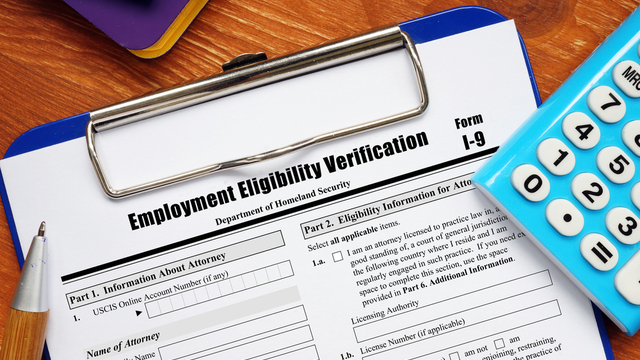Like nearly all aspects of employment law today, immigration law hasn’t been immune from the effects of the COVID-19 pandemic. The trend is likely to continue throughout 2022, particularly with regard to employment authorization documentation. The federal government is looking to consider additional flexibility for employers working to comply with the requirements.
What Employers Need to Know
Form I-9. Every U.S. employer is required to complete the Form I-9 for any newly hired employee (regardless of immigration status) to verify their eligibility to work in the country. The rule became part of employment immigration law after Congress passed the Immigration Reform and Control Act of 1986 (IRCA).
Ten years later, the Immigration Reform and Immigrant Responsibility Act of 1996 required the then-Immigration and Naturalization Service (now the U.S. Citizenship and Immigration Services or USCIS) to create a pilot program to develop an online system so registered employers could quickly verify employment eligibility. Since the rule’s implementation, employers historically have created workers’ I-9s by hand and in paper form, even after the government created the digital E-Verify platform.
E-Verify. Administered by USCIS, E-Verify is a free, mostly voluntary web-based tool that allows employers to verify any newly hired employee’s employment authorization electronically. The system is seen as the silver bullet to combat widespread document fraud enabling the employment of undocumented workers.
E-Verify compares information from an employee’s Form I-9 to data from the U.S. Department of Homeland Security (DHS) and Social Security Administration records to confirm employment eligibility according to USCIS. Initially, the program was available in only a handful of states, but it has become an option for employers nationwide. Several states mandate it, and federal contractors are also required to use it.
No Flexibility Before 2020
For the last 25 years, the U.S. government has required I-9 and E-Verify records to be completed in-person and maintained on-site by an employer. The process remained unchanged until 2020. When developing the administrative framework, the government didn’t provide flexibility to employers for I-9 purposes, nor did it properly consider the future impacts of technology and socioeconomic changes on companies and their workers.
Most notably, within the I-9 regulations, there was no flexibility for the fact that not every worker in the country is required to commute into their employer’s office regularly, nor was any consideration given for procedural flexibility regarding how employers could properly complete the forms and verify worker employment eligibility documentation during a global pandemic, especially when in-office activities have been limited or eliminated.
Modifications in the Wake of COVID-19
Since the COVID-19 pandemic’s onset in 2020, the government has temporarily shifted its previously inflexible stance and now permits the filing of remotely signed and verified Forms I-9. In March 2020, DHS began temporarily permitting remote verification of identity and work authorization documents for newly hired and rehired employees within the I-9 form onboarding process.
One caveat: Employers that had remotely verified the I-9 forms would need to conduct in-person verification when the employees returned to on-site work.
Temporary Solutions May Become Permanent
Nearly two years later, COVID-19’s remote work era shows no signs of letting up, with ongoing ramifications for U.S. employers and foreign employees. Although DHS and USCIS intended for the I-9 remote exceptions to be a temporary solution until the pandemic subsided, their stance may be changing with the rapid transformation of the economic landscape and the increasing number of remote workers.
Confronted with the difficulties of I-9 administration faced by employers with the new remote work paradigm, USCIS recently issued a notice seeking public comment about extending its temporary, more flexible verification policy. The move makes it appear the agency may be considering additional I-9 flexibility and perhaps implementing new regulations so employers can administer I-9s remotely beyond COVID-19.
Interestingly, in November 2021, USCIS automatically extended employment authorization documents (EADs) for foreign nationals in certain employment eligibility categories (restricted to specific, limited classifications) who file Form I-765 to renew their EADs. Under the approach, they may receive automatic extensions of their work authorization and/or EAD for up to 180 days as long as they have a valid I-94 (a document authorizing a foreign national’s period of stay) beyond the expiration of their EAD. The change allows:
- Immigrant employees with valid I-94s facing long USCIS EAD processing times to retain continued employment authorization; and
- Employers to employ them based on lawful I-9 verification for a six-month period.
In December 2021, DHS and U.S. Immigration and Customs Enforcement (ICE) announced an extension of the flexibility for the remote I-9 verification exception in complying with requirements related to the form because of COVID-19 until April 30, 2022. With remote work becoming the new normal, DHS’s agencies are confronting the difficulties imposed by the I-9 regulation as it stands.
For the time being, however, all U.S. employers remain legally obligated to reverify in-person all I-9s completed while an employee is working remotely, which presents issues when a remote worker departs for a new company.
Takeaways for Employers
Given COVID-19’s unpredictable and ever-changing impacts on the workplace, U.S. employers would be wise to regularly monitor the Federal Register and DHS agency announcements or contact their immigration and employment law counsel for updates and developments to ensure their company remains I-9-compliant.
Roger Tsai is a partner in Holland & Hart, LLP’s labor and employment practice group. Noah Lynch is an immigration specialist in the group. They practice out of the firm’s Denver office, and you can reach them at rytsai@hollandhart.com and ndlynch@hollandhart.com.
The post More Flexibility with Form I-9 Compliance Expected in 2022 appeared first on HR Daily Advisor.
